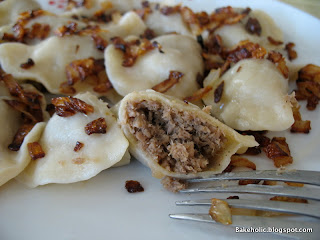Poppy-seed Cake (Makowiec)
The poppy seed cake is a traditional Polish pastry served in a form of rolled yeast bread stuffed with dense poppy seed filling. Although by many Poles it is considered to be a national dessert, it is also popular in parts of Central and Eastern Europe and in Israel.
Poppy-seed roll in Poland is called makowiec.
in Hungary - mákos bejgli
in Russia bulochki s makom (булочки с маком)
in Serbia маковњача
in Bosnia makovnjača
in Czech makový závin
in Slovak makovník
in Lithuanian aguonų vyniotinis
in Croatia makovnjača
in Romania rulada cu mac or rulada cu nuci
in Austria Mohnkuchen or Mohnstriezel
Recipe:
Ingredients:
1/2 pound
of poppy seed
3/4 cup
of white sugar
1 tablespoon
of melted butter
1 teaspoon
of lemon juice
1/2 cup
of hot milk
1 (.25 ounce) package
of active dry yeast
1/2 cup
of warm water
2 tablespoons
of white sugar
2 cups
of all-purpose flour
1/2 teaspoon
of salt
1/4 cup
of butter
1
egg, separated - white reserved
Directions:
- Place poppy seeds into a food processor and process about 1 minute ( seeds should be ready when the white liquid appears).
- Mix grounded poppy seeds with 3/4 cup of sugar, 1 tablespoon of melted butter, lemon juice, and hot milk in a bowl (stir until all ingredients combine)
- Cover poppy seed filling and put it to the fridge while making the dough (filling will set up and thicken as it chills).
- Mix dry yeast with water and 2 tablespoons of sugar in a small bowl. Put it aside until the yeast forms a creamy layer.
- Mix flour with salt in a bowl and slowly add your butter into the flour until the mixture resembles coarse crumbs.
- Pour yeast mixture and egg yolk into flour mixture and stir to make a soft dough.
- Turn dough out onto a floured work surface and knead until smooth and slightly springy, about 5 minutes. If dough is too sticky, knead in more flour, about 2 tablespoons at a time.
- Cut dough into 2 equal pieces. Roll each piece out into a 12x16-inch rectangle.
- Spread half the poppy seed filling over each rectangle, leaving a 1-inch border. Fold the 1-inch border back over the filling on all sides and press down.
- Pick up the shorter side of a dough rectangle and roll it like a jelly roll; repeat with second rectangle. Pinch ends together or tuck ends under to prevent filling from leaking out.
- Bake your roll in the oven ( in 200 C) until the top gets brownish.
- Enjoy your pastry :)


